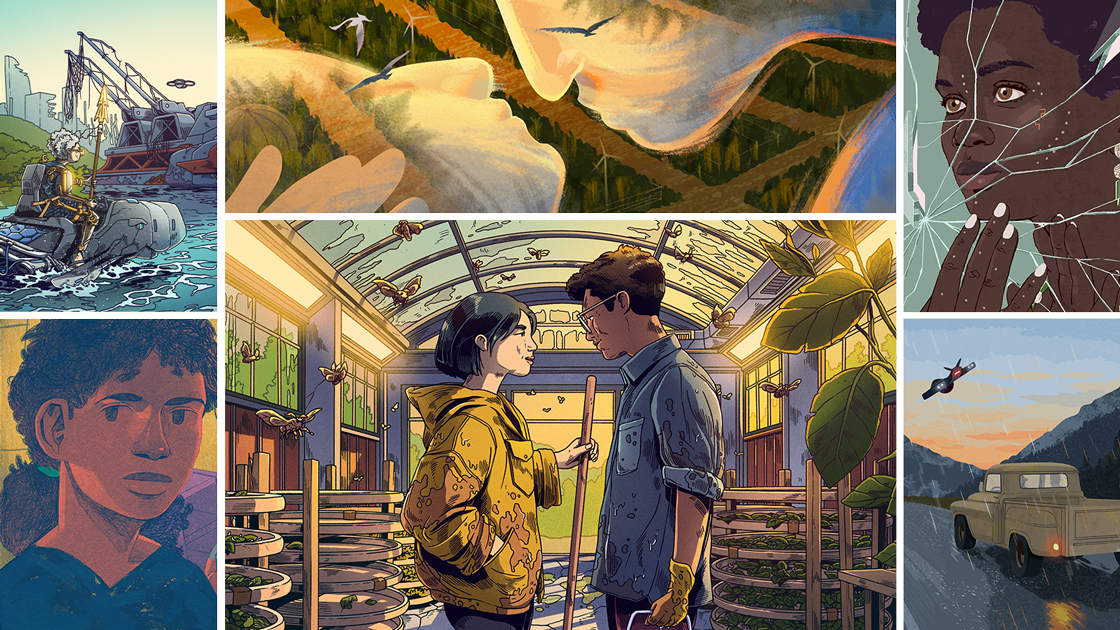Each time we’ve published a new set of Imagine 2200 winners, I’ve found myself drawn to a particular facet of this project, a core element that defines our approach to climate fiction here at Grist and what makes Imagine unique. In past years, I’ve pondered the origin story of Imagine and the rich literary legacies that inspired the team, the powerful role our imaginations play in shaping the world we wish to see, and the importance of hope and why we emphasize solutions. This year, my reflections turn to another crucial, yet often overlooked, aspect: the profound importance of culture in shaping the narratives of climate fiction.
[Explore the 2025 Imagine collection]
Imagine 2200 is a global project. For this year’s contest, our fourth, we received over 1,200 stories from more than 100 countries. The international aspect is one of my favorite parts of our approach to climate fiction, not just for the opportunity it provides global authors to try their hand at a speculative and imaginative genre, but also for the opportunity it provides us as readers to step inside another culture. This year’s winning stories include writers and characters from the bustling metropolis of Lagos, Nigeria, to the snowy landscape of Buffalo, New York, to a multi-generational household in the Caribbean.
To create such a diverse collection, we partner with all sorts of literary organizations and people to reach writers around the world. Making these connections is one of my roles, and it’s a fun one. I’ve connected with communities from the Himalayan Writers Workshop to PEN International, and writers from across the globe, including Italian translator and writer Francesco Verso, who encouraged me to read climate and speculative fiction from far off places, and to prioritize this kind of relationship building. (Check out his anthology Solarpunk if you are looking for more climate fiction, featuring many friends of Imagine!)
Through each of these connections I’ve seen anew the profound value of the global community and the understanding that each of our cultures, with their unique wisdoms, holds invaluable perspectives on how we can collectively achieve a clean, green, and just world.
The cultural diversity we humans offer each other is one of our greatest and most beautiful gifts. Stories that imagine the future can often treat culture as an afterthought, or assume that future societies will be homogenous and devoid of culture diversity. But there’s something powerful in stories that reflect the complexity of the human experience and the challenges we face, and celebrate people’s culture, heritage and perspectives as a part of what there is to save – not as something we can stand to lose. After all, this diversity of experience and perspective is our greatest asset in coming up with solutions.
This is why we believe the best climate fiction stories, and certainly the best Imagine 2200 stories, not only showcase beautiful writing and interesting climate solutions, but are deeply rooted in culture and heritage.
You’ll find that in spades in the winners and finalists of our 2024/2025 contest. For example:
The Ones Left Behind takes place in a Sichuan restaurant in New York, where Grace carries on the family’s craft of raising silkworms and the mulberry trees that feed them, to make the restaurant’s signature dish. The practices form part of a long tradition passed down between the generations that Grace honors throughout the story.
The Isle Of Beautiful Waters unfolds in Guadeloupe, and vividly captures Caribbean culture and traditional practices. The multi-generational story emphasizes the importance of oral storytelling, and offers a subtle yet powerful focus on the impact of colonialism on the people and landscape.
To Rescue a Self transports readers to the heart of a future Lagos, Nigeria, where the aroma of moi moi and akamu fill the living quarters of an environmental fellowship retreat, and the lively banter with hints of Nigerian slang and pidgin paints a vivid picture of everyday life.
In these and other stories from around the world, you’ll get a taste (almost literally, in the case of The Ones Left Behind) of cultures and how their traditions contribute to unique approaches to climate solutions.
Among these stories, you’ll also find fantastical elements, which is perhaps unusual in climate fiction, but a frequent characteristic of an Imagine story. Many cultures employ magic and fantasy as allegories, and we welcome that as a part of exploring how to understand the future.
For example, in this year’s winning story, Meet Me Under the Molokhia, the main character, Nadia, encounters Zahra, a mysterious spirit who challenges her perceptions of reality. At its heart, Meet Me Under the Molokhia is a touching exploration of grief, healing, and the enduring power of human connection amidst a backdrop of environmental and societal upheaval, and writer Sage Hoffman Nadeau weaves together scientific concepts, cultural traditions, and fantastical elements to create a richly layered and emotionally resonant narrative.
Imagine’s core purpose is to encourage writers to turn their pens to imagining the futures they want to see, a challenge that allows us to envision the path to climate solutions in the here and now. That is not possible without also encouraging writers to bring their full selves to that process, allowing their experiences and cultures to drive their unique visions. By embracing cultural diversity, we can tap into humanity’s collective wisdom and increase our chances of finding effective solutions.


